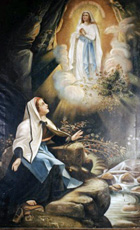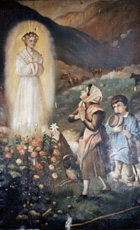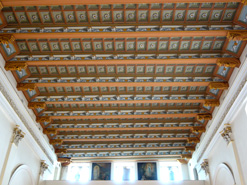| |||||||||||||||||||||||||||||||
Was completed in 1601 and, as is written in a memorial tablet of the cantors zone, restored and decorated in 1891, with the addition of three double lancet windows placed between the superior portal and the triangular tympanum. It is located on the corso Umberto, on a strongly sloping ground, in a highly banked position, connected to the roadbed by a long flight of steps in lava stone. The edifice is dedicated to Madonna Of The Chain or Santa Maria Of The Snow (ad nives), to which the brontesi are very devout and to which, during the centuries, many times the farmers addressed prayers and asked protection against the drought which was threatening their crops.
The church pediment with a beautiful portal with curvilinear tympanum is made of lava stone and held by Corinthian columns. | |||||||||||||||||||||||||||||||
| |||||||||||||||||||||||||||||||
| ||||||||||||||||||
| ||||||||||||||||||
The Little Seminary
The Little Seminary was once the seat of the ancient San Filippo Neri Oratory. The Oratory of S. Phillip Neri was built, adjoining the church, during the first years of 1600, together with the Philippine fathers who, for centuries, performed activities of elementary instruction (“Little Grammar School”) in favor of needy class. Here started also the first studies of Nicola Spedalieri and the Ven. Ignazio Capizzi. Part of the ancient Philippine oratory was later rebuilt and, in a very large room were put up poor and old beggars. In 1922 the priest Giuseppe Salanitri, with the help of Cardinal Nava and the income from a pistachio grove belonging to the church (‘u locu ‘a Catina), made of the Philippine Oratory the seat of the Piccolo Seminary still in existence. Father Giuseppe Salanitri was born in Bronte the 19th of August 1874, studied at the Capizzi College and, ordered priest in 1897, as a true educator dedicated his life to the Christian formation of young people. The Piccolo Seminary, founded by him in 1922, has educated very many Bronte’s young men and remains yet his living testimony. He was also active in the social and political activities of Bronte: was often town councilior, president of the Cassa Agricola Nicola Spedalieri, founder, with others, of the Popular Party of Bronte. | ||||||||||||||||||
| ||||||||||||||||||
 The church of Santa Maria Of The Chain ("Santa Maria della Catena") was founded in 1569, by the generosity of Don Antonino Lombardo, baron of Rivolia. Wasn't yet finished in 1574, during the pastoral visit of the Monreale bishop Mons. Torres in Bronte, but already appears few years later: in the reveals of 1584 and in matrimonial registers of 1589.
The church of Santa Maria Of The Chain ("Santa Maria della Catena") was founded in 1569, by the generosity of Don Antonino Lombardo, baron of Rivolia. Wasn't yet finished in 1574, during the pastoral visit of the Monreale bishop Mons. Torres in Bronte, but already appears few years later: in the reveals of 1584 and in matrimonial registers of 1589.

 The inside is typical in Bronte's churches, one only hall with semicircular apse and cantor's place that impends over the entry zone of the nave.
The inside is typical in Bronte's churches, one only hall with semicircular apse and cantor's place that impends over the entry zone of the nave. In the niche of the major altar, between duplicated Doric columns and above tympanum, stands the marble statue of the Madonna della Catena or Santa Maria Of The Snow (that the Radice judges of the Gagini school). A painted marble coat of arms is found under the statue.
In the niche of the major altar, between duplicated Doric columns and above tympanum, stands the marble statue of the Madonna della Catena or Santa Maria Of The Snow (that the Radice judges of the Gagini school). A painted marble coat of arms is found under the statue.








 It is also worth citing the devotion (by now almost disappeared and obsolete) and the prayers that Bronte’s peasants for centuries turned to Maria SS. della Mercede. The statue of the «Maronna Miccera» is placed on an altar dedicated to her; it is made of painted papier-mâché, 140 cm high and was made during the 19th century. It was carried in procession whenever a drought threatened the harvest.
It is also worth citing the devotion (by now almost disappeared and obsolete) and the prayers that Bronte’s peasants for centuries turned to Maria SS. della Mercede. The statue of the «Maronna Miccera» is placed on an altar dedicated to her; it is made of painted papier-mâché, 140 cm high and was made during the 19th century. It was carried in procession whenever a drought threatened the harvest.





 On the left wall hangs a beautiful painting depicting the Martyrdom of Saint Stephen (4). The canvas, painted in oil by
On the left wall hangs a beautiful painting depicting the Martyrdom of Saint Stephen (4). The canvas, painted in oil by 



 Next to the Chiesa della Catena (on the right) there is now the Little Seminary (well-deserving Institution founded in1922 by father Giuseppe Salanitri) and the ancient San Carlo Oratory (with a fair number of 17th century pictures) seat of the same San Carlo confraternity founded during the XVI century.
Next to the Chiesa della Catena (on the right) there is now the Little Seminary (well-deserving Institution founded in1922 by father Giuseppe Salanitri) and the ancient San Carlo Oratory (with a fair number of 17th century pictures) seat of the same San Carlo confraternity founded during the XVI century.
